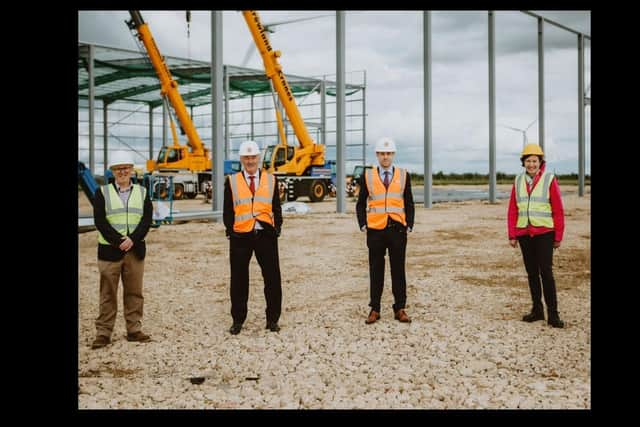Building under way at Chelveston Renewable Energy Park as £2.35m carpet recycling plant takes shape
and live on Freeview channel 276
The UK’s very first carpet recycling facility is under construction – with work now under way at the plant on Chelveston Renewable Energy Innovation Park.
Innovate Recycle, awarded a £2.35m award from the South East Midlands Local Enterprise Partnership (SEMLEP) Getting Building Fund last year, is set to change the country’s approach to carpet waste and save thousands of tonnes from landfill and incineration.
Advertisement
Hide AdAdvertisement
Hide AdThe facility, set to be the first new build on Chelveston Renewable Energy Park when it opens in January 2022, will help the UK reduce its plastic waste and will be run solely on the wind, solar and hydrogen renewable power produced at the park.


Joseph Eccleston, CEO of Innovate Recycle, inherited his family’s carpet business and was immediately struck by the scale of waste.
He said: “There is a need for change and the statistics are staggering. About 500,000 tonnes of waste carpet are produced in the UK every year, more than half of which goes to landfill. Most of the rest is incinerated to produce energy or shredded and used in equine arenas.
“It is a waste of the retrievable polypropylene, environmentally unsustainable and I’m determined to change it. The alternatives to landfill involve us continuing to burn fossil fuel or shredding the carpet into tiny plastic and fibre shreds which are all too easily spread across our landscape”.
Advertisement
Hide AdAdvertisement
Hide AdInnovate Recycle will recycle and deconstruct polypropylene-based carpets at volume. This process will see the polypropylene converted into fibre and then into pellets, which will be sold on to a range of sectors including the automotive industry. The pellets will be also be used in the production of products including buckets, water butts and watering cans, 3D printing materials, battery cases, and storage bins.
Bob Woods, chair of the board of Innovate Recycle, said: “Carpets cannot continue to be sent to landfill, incinerated or repurposed into products that damage the environment which is why we are at the forefront of new technology and developing a new circular economy approach for the carpet industry. This new technology and approach will create a unique and sustainable process, one that will produce quality material that can be recycled time and time again.”
Working closely with the UK’s carpet industry to improve the environmental performance of carpet manufacturing, Innovate Recycle will source and recycle waste carpets from across the South East Midlands.
Government circular economy and environmental policy, such as the 30 per cent recycled content in plastic packaging proposals from 2022, means that quality pelletised recycled material from the plant will help the UK to progress to net carbon zero. It will also provide the opportunity for new products and advancement, helping to place Northamptonshire at the forefront of a growth industry.
Advertisement
Hide AdAdvertisement
Hide AdJudith Barker, director of programmes and governance at SEMLEP, added: ”This innovative project is a UK first and is not only tackling the issue of excessive waste and landfill, but is also being run on renewable energy – a truly impressive feat and one that SEMLEP is delighted to be supporting.”
The Chelveston Renewable Energy Park, built on the former Second World War airbase, uses a multitude of different renewable technologies to generate clean energy including wind turbines, solar panels, and a hydrogen generation facility.